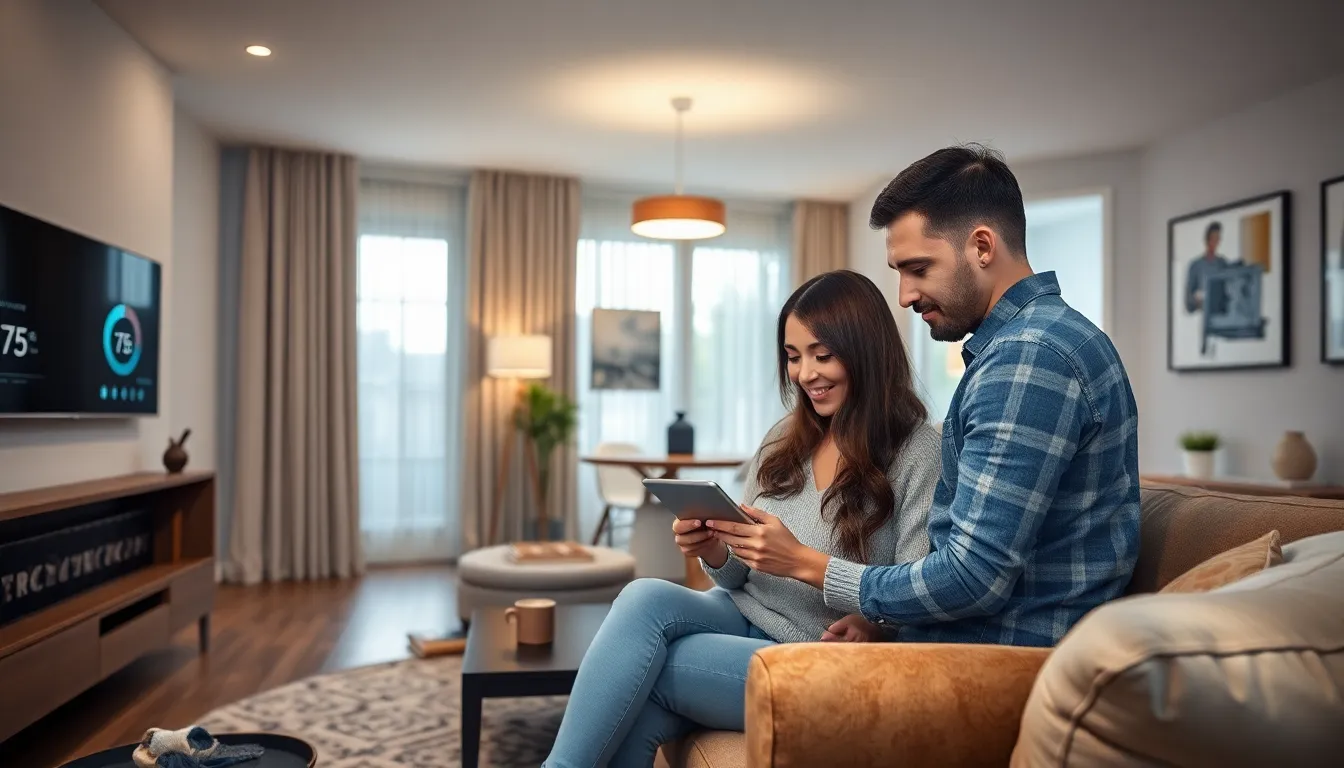Imagine walking into your home and having the lights flicker on as if they’re excited to see you. Smart home automation systems make this dream a reality, turning everyday living into a scene from a futuristic movie. With a simple voice command or a tap on your smartphone, you can control everything from your thermostat to your coffee maker. Who knew being lazy could be so high-tech?
These systems aren’t just about convenience; they’re about creating a lifestyle that’s energy-efficient and secure. Picture a home that learns your habits, adjusts itself accordingly, and even alerts you to potential intruders. It’s like having a personal assistant who never complains and doesn’t need coffee breaks. As technology continues to evolve, smart home automation is becoming more accessible, making it easier than ever to transform any space into a smart sanctuary.
Table of Contents
ToggleOverview Of Smart Home Automation Systems
Smart home automation systems transform living spaces into highly efficient environments. These systems enable users to manage devices like lights, thermostats, and security cameras from their smartphones or through voice commands. Integration with smart assistants such as Amazon Alexa or Google Assistant enhances user experience, providing hands-free control.
Convenience ranks among the primary benefits of smart home automation. Users can schedule tasks, such as turning off lights or adjusting thermostats, maximizing energy efficiency. Studies show that smart thermostats can reduce energy consumption by 10 to 15 percent, leading to significant savings.
Learning capabilities also play a crucial role. Many systems adapt to individual preferences, allowing personalized settings for lighting and temperature. This adaptation not only promotes comfort but also increases overall satisfaction.
Security features provide peace of mind. Smart home automation systems include door locks, motion sensors, and surveillance cameras, which can be monitored remotely. According to research, homes with smart security systems are less likely to experience burglaries.
Interoperability between devices enhances the functionality of smart home systems. Compatibility among various brands and products allows seamless device communication, creating a cohesive network. This integration can lead to a more streamlined user experience and increased operational efficiency.
The accessibility of smart home automation systems continues to improve. With prices becoming more competitive, more homeowners are adopting these technologies. As advancements in IoT and AI technology persist, the adoption rates are likely to surge, making smart homes an integral part of modern living.
Key Benefits Of Smart Home Automation

Smart home automation systems offer several key advantages that enhance daily living. These benefits include increased convenience, enhanced security, and energy efficiency.
Increased Convenience
Convenience comes first, enabling users to control multiple devices from a single interface. Smart homes allow residents to adjust lighting, temperature, and appliances with voice commands or smartphone apps. Hands-free control simplifies tasks, making daily routines more manageable. Customized settings cater to individual preferences, ensuring comfort at all times. Scheduling features automate actions such as turning lights on at sunset or adjusting thermostats before residents arrive home. Integration with smart assistants like Amazon Alexa or Google Assistant streamlines user interaction, enhancing the overall experience.
Enhanced Security
Enhanced security ranks high among the benefits of smart home automation systems. Smart security features include remote door locks and surveillance cameras, contributing to a safer living environment. Users can monitor their homes in real time through mobile apps, which fosters peace of mind. Alerts about unusual activity ensure residents remain informed about potential threats. Homes with smart security systems face a lower risk of burglaries, often deterring intruders. Furthermore, automation can be set to simulate occupancy when residents are away, enhancing security while providing an added layer of protection.
Energy Efficiency
Energy efficiency showcases significant advantages of smart home automation technologies. Smart thermostats achieve reductions in energy consumption by 10 to 15 percent, optimizing heating and cooling based on user habits. Automated lighting systems adjust in response to natural light levels, ensuring the best use of electricity. Remote management of devices allows users to turn off appliances when not in use, preventing unnecessary energy waste. Collectively, these measures contribute to lower utility bills while supporting environmentally friendly living. Enhanced energy savings incentivize homeowners to adopt smart technology, further promoting eco-conscious choices.
Popular Smart Home Automation Systems
Smart home automation systems come in various types and brands, offering users flexible options tailored to their needs.
System Types
Homeowners can choose from several system types, including standalone systems, which control specific devices or functions. Integrated systems allow for central control over multiple devices, enhancing interoperability. Hub-based systems connect different devices through a central hub, promoting seamless communication. Cloud-based systems rely on internet connectivity, enabling remote access and control from anywhere. Each type provides varying degrees of customization and automation, allowing users to find the solutions that best suit their lifestyles.
Leading Brands
Several leading brands dominate the smart home automation market. Amazon offers the Alexa-enabled Echo devices, which control compatible smart home devices with voice commands. Google provides the Nest ecosystem, known for its intuitive learning capabilities and energy-efficient options. Apple’s HomeKit offers a secure and user-friendly platform that integrates well with iOS devices. Samsung’s SmartThings stands out for its broad compatibility with other brands and devices. These brands consistently innovate, ensuring improved technology and user experiences in smart home automation systems.
Installation And Setup
Smart home automation systems require careful installation and setup to maximize their benefits. Users typically face two main options for installation.
DIY vs. Professional Installation
DIY installation appeals to those who enjoy hands-on projects. Many systems come with user-friendly guides that make it accessible to install devices independently. However, professional installation ensures proper setup for more complex systems. Professionals possess experience with wiring and network configurations, reducing the likelihood of issues. Users may consider their comfort level with technology when deciding. Those with minimal tech skills might prefer hiring a professional to streamline the process. Ultimately, the choice depends on individual preferences, budget, and available time.
Common Setup Challenges
Several challenges arise during the setup of smart home automation systems. One common issue involves device compatibility, as not all brands work seamlessly together. Users may experience difficulty integrating devices into a unified system. Another challenge includes Wi-Fi connectivity, where weak signals can lead to device malfunctions. Users might also encounter issues with app navigation, especially when configuring settings or scheduling tasks. Finally, unexpected software glitches may arise, requiring troubleshooting expertise. Being aware of these challenges helps users prepare for a smoother installation experience.
Future Trends In Smart Home Automation
The landscape of smart home automation is rapidly evolving. Increased integration of artificial intelligence enhances automation capabilities significantly. Devices learn user behaviors, enabling personalized settings for added comfort.
Voice control continues to gain traction, with improvements in natural language processing making interactions smoother. It becomes easier for users to engage with devices just by speaking. Compatibility with various smart assistants expands, allowing seamless control across multiple platforms.
Sustainability is crucial, with manufacturers focusing on energy-efficient technologies. Appliances designed to minimize energy consumption contribute to lower utility bills while promoting eco-friendly practices. Smart thermostats, for instance, already save users 10 to 15 percent on energy costs.
Security advancements are on the rise too. Enhanced features like facial recognition and smart locks improve home safety dramatically. Systems with integrated surveillance cameras provide real-time alerts, making monitoring straightforward.
Interconnectivity among devices increases functionality as well. Users benefit from ecosystems where devices work in harmony, leading to more efficient household management. Hub-based systems streamline interactions, reducing the complexity of controlling various devices.
Emerging technologies such as 5G will further transform smart home automation. Faster internet speeds will enable devices to communicate instantly, improving responsiveness and reliability. Developments in machine learning will support smarter decision-making within homes.
Affordability of smart home systems improves access for a wider audience. Competitive pricing encourages homeowners to adopt automation technologies, increasing overall demand. As the market diversifies, options will cater to varying budgets and preferences, further driving adoption.
Smart home automation systems are revolutionizing the way people interact with their living spaces. With the ability to control devices through voice commands and apps they offer unparalleled convenience and energy efficiency. As technology continues to advance the integration of AI and IoT will only enhance these systems further.
Homeowners can enjoy increased security and personalized comfort while also benefiting from lower utility bills. The growing accessibility and affordability of these systems mean more individuals can experience the advantages of smart living. As smart home technology evolves it promises to create a more efficient and secure future for all.


